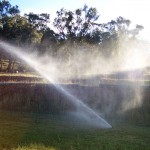Brown is the new green — really!
August 28, 2016As summer draws to a close, we’re under a drought watch in Lehigh and Northampton counties. While there currently are no water restrictions, voluntarily cutting back your water use would be helpful.

One of the best ways to do that, especially this time of year, is to stop watering your lawn. While many people think their lawns will shrivel up and die, it actually can help your lawn prepare for fall and winter. By cutting back on water, the lawn begins to go dormant. It’s something that usually occurs naturally in the hottest months anyway, as the lawn protects itself against heat and dry conditions.
When it rains, the lawn will green up again all by itself.
You can also consider investing in a drought-resistant species of grass, which could be planted in fall or spring.
Another method is to eliminate your lawn altogether. While this might not be practical for some with large swaths of grass, smaller lawns can be converted into gardens rather easily — and often inexpensively, too.
In California, many homeowners are finding that covering their grass with sheets of cardboard and mulch — which kills the grass while preserving the topsoil — and then planting native species has saved them time, money and water. No more grass to mow, but plenty of butterflies and birds that are attracted to the much more earth-friendly replacement.